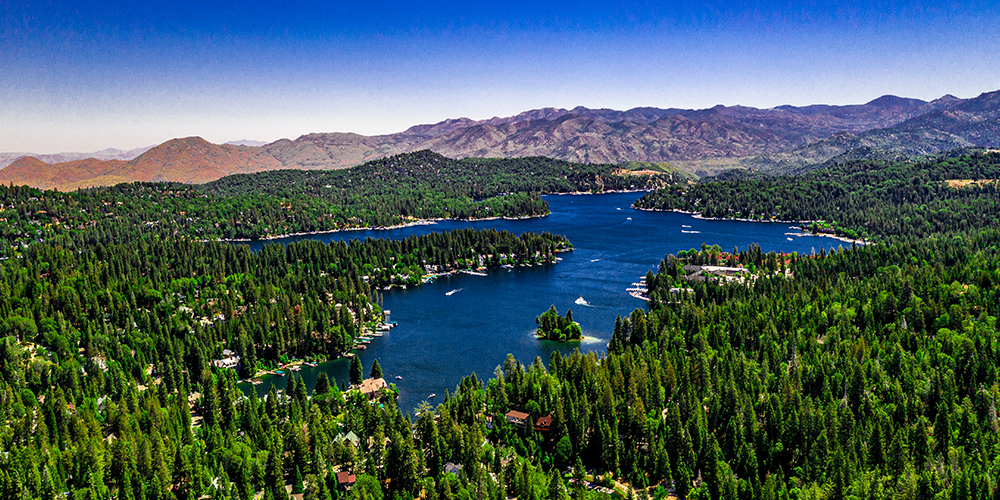Over the last decade, many California lakes have dealt with cases of blue-green algae blooms. Experts believe that the cyanobacteria spawns largely as a result of drought, which is why they were especially bad in 2016. Unfortunately, reports of illness linked to the blue-green algae have also spiked. In response, the Department of Water Resources has sent out notices urging swimmers to avoid physical contact with bodies of water that contain the cyanobacteria.
Fortunately, Lake Arrowhead isn’t currently facing this problem, but it’s important you know what the toxic algae looks like, the dangers it poses, and what you can do to prevent it.
Blue Green Algae in Lake Arrowhead: What You Need to Know
In 2016, the Press Enterprise Reported this:
This year, 32 lakes, streams, and reservoirs throughout the state, including Riverside and San Bernardino counties, have been hit with significant algae blooms, the California Water Quality Monitoring Council reported last week. The incidents, primarily spawned by low water levels, excessive heat and high nutrient content, have prompted temporary shutdowns to boating, swimming and other activities or led to advisory warnings.
The health risk they posed impacted various lakes, reservoirs, and streams in California, causing concern in both health officials and the general public.
What Exactly is Blue-Green Algae?
Although it’s called algae, it isn’t quite that. In truth, it’s a cyanobacteria—a microscopic bacteria typically found in bodies of water—that mimics the behavior of algae. The toxic strain is known as microcystis – a dangerous toxin that can cause allergic reactions, fever, gastrointestinal illness, joint pain, liver damage, skin irritation, and cancer.
According to the Daily News, “There are no confirmed human deaths from cyanotoxins in the U.S., but there are documented fatalities in other countries. In Brazil, 60 dialysis patients died in 1996 after being exposed to toxins in the water supply.” Despite that, there have been reports that multiple pets have died from drinking or playing in toxic blooms.
What Does it Look Like?
Algae blooms can take on a range of colors and appearances. There’s no way to tell if its toxic by simply observing it. That said, it typically looks as follows:
- Blue-green in color, although it can range to browns or reddish-purples
- Can be unicellular, colonial, or filamentous
- Buoyant with a scum layer that floats on the water’s surface
Symptoms of Toxins Poisoning
To avoid contact, it’s best to stay away from lakes, ponds, or streams where blue-green algae is present. Children and pets should be kept away from bodies of water that resemble the description above, seeing as their bodies are more susceptible to the toxins.
If you do get it on your body, rinse off using fresh water immediately. If your pet drinks it, call a vet at once. Symptoms of exposure in humans include difficulty breathing, vomiting, diarrhea, skin irritation, nausea, numbness in extremities, and loss of appetite. Symptoms of exposure in pets include fatigue, difficulty breathing, vomiting, convulsions, allergic skin rash, and even death.
What Can I Do?
If you’re a Lake Arrowhead resident, there are several things you can do to help prevent it from cropping up in our lake. Actions include:
- Use fertilizer that’s free of phosphate – If you must use fertilizer, make sure that the kind you use doesn’t have phosphorous in it. Lake officials say that one pound of phosphorus can produce up to 500 pounds of algae.
How do you know whether or not the bag is phosphate-free? All bags have 3 numbers on them that state the percentage of nitrogen, phosphorus, and potassium. You want to find a bag that has a zero in that middle figure.
- Don’t use fertilizer close to the lake – Denville’s county ordinance mandates that residents avoid using fertilizer within 10 feet of the lakes. Following those rules will help prevent large amounts of fertilizer from poisoning the waters.
- Clean up your leaves and waste – Algae blooms feed off of decomposing leaves and/or waste. So, be sure to clean up after your pets, keep your lawns cleaned, and avoid any instances where waste can build up.
- Build a rain garden – Runoff from lawns and/or yard plants also feed blooms. Ideally, you want to set up a buffer zone of native trees, shrubs, grasses, and wild flowers to help filter polluted runoff.
Blue-Green Algae
Thankfully, we’re not currently dealing with any algae hazards in Lake Arrowhead. However, it’s important that you know what it looks like so you can keep your loved ones and pets safe, and so that you can do your part to keep the lake healthy and clean. If you do spot a bloom, be sure to report it to the Lakes Committee, who have devoted time and money towards tackling this problem and keeping Lake Arrowhead residents safe.
Sources:
Texas A&M Agrilife. Blue-Green Algae (Cyanobacteria).https://aquaplant.tamu.edu/blue-green-algae/
The Press-Enterprise. What You Need to Know About Blue-Green Algae. (2016). https://www.pe.com/2016/09/02/what-you-need-to-know-about-blue-green-algae/
Baer, S. Daily News. Wading into Danger. (2016). https://projects.dailynews.com/blue-green-algae/


I hope that you won’t stop writing such interesting articles. I’m waiting for more of your content. I’m going to follow you!